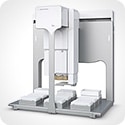Access Agilent eNewsletter February 2015
>> Update My Profile | Subscribe to Access Agilent | Article Directory

Agilent Bravo Platform speeds university medical research
By Kasia Proctor
Agilent Senior Product Manager, Automation Systems
Good research requires time for exploration, so doing good research and saving time seem to be incompatible goals. But if your research requires sample preparation with multiple small-volume liquid handling steps, the Agilent Bravo Automated Liquid Handling Platform will indeed hasten the process. Two case studies show how scientists use the system to accelerate clinical research on biomarker discovery and on telomeres and microRNA.
At King’s College, Agilent Bravo Platform hastens the hunt for biomarkers
The samples come from hundreds of people. Some are healthy, some have high blood pressure, and some have already had heart attacks.
From the blood of these subjects, scientists at King’s College London, one of England’s top-tier research universities, hope to uncover clues that may one day help doctors detect cardiovascular and metabolic diseases before they become serious problems.
Their approach sounds simple enough: “When we see, OK, this cluster of RNAs has been regulated up or down before a cardiovascular event, this could be a diagnostic biomarker,” says Dr. Philipp Skroblin, a research associate with the British Heart Foundation Centre of Research Excellence at King’s.
Given reliable biomarkers, doctors could alert their patients to potential problems and take preventive action.
 Enlarge
Enlarge
Figure 1. Duplicate analyses in black and gray show the outstanding reproducibility of the Bravo Platform used for biomarker discovery.
“The accuracy of the Bravo Platform is really good. We save time and we save a lot of money because, compared to the other automated system, we need fewer tips.”
A faster, easier, more accurate platform
At King’s, clinical research in biomarker discovery is accelerated with the help of the Agilent Bravo Automated Liquid Handling Platform. Not only is the Bravo Platform faster and easier than manual methods, it is far more efficient (and cost-effective) than the lab’s previous automated system.
“The difference is the Bravo Platform has multiple pipet tips, so you can do reactions in parallel. The other system had only one pipet, so it took nearly two hours to load a plate – and we were not really happy with the reliability of the results. We had some weird outliers and when we did replicates of one sample we did not get reproducible results. That’s why we went with the Bravo,” Skroblin explains.
Figure 1 demonstrates the Bravo reproducibility. One sample and master mixes for five different targets were pipetted in duplicate to 20 different 384-well plates using the Bravo. The figure shows the CT (threshold cycle) values obtained for the duplicates (black and gray) in subsequent qPCR (quantitative polymerase chain reaction) analyses. The results are highly reproducible across all plates and within a wide CT range.
“The accuracy of the Bravo Platform is really good. We save time and we save a lot of money because, compared to the other automated system, we need fewer tips. With the other system we could use each tip only once. With the Bravo, on the other hand, the tips don’t come into contact with our master mixes, so they can be reused to dispense samples to multiple wells containing different master mixes without cross-contamination. That’s a big plus for us. With the Bravo, depending on the layout of the plate, we use only 30 to 40 pipet tips per plate. With the previous system it was more than 400.”

Figure 2. Dr. Tahara and his assistant use the Bravo Platform to accelerate their research on the shortening of telomeres and the relationship to aging and cancer.
The Bravo’s biggest advantage is “reproducibility and the reduction of damage to cells.”
At Hiroshima University, Agilent Bravo Platform expedites research into telomeres and microRNA
Dr. Hidetoshi Tahara, Professor of Cellular and Molecular Biology at Hiroshima University in Japan, is looking for the predecessors to aging and cancer.
That is the reason he and other scientists study telomeres – the caps on the ends of our chromosomes that keep our genetic data from unraveling. Telomeres get shorter each time a cell divides. Too short, and the cell can no longer divide. It becomes inactive or dies.
Dr. Tahara’s laboratory, founded 2006, examines how this shortening process relates to aging, cancer, and an elevated risk of death.
Tahara and his team are doing fundamental research – focused primarily on telomeres and the therapeutic role of microRNA – in an effort to promote human health and longevity.
Assay automation reduces cell damage
Tahara’s team had been performing thousands of cell-based assays by hand. “Though it was not an impossible number to process by hand, the cells had been damaged as time goes by,” he says.
Enter the Agilent Bravo Automated Liquid Handling Platform. Tahara describes the Bravo Platform as compact, easy to use, and easy to keep clean.
Its biggest advantage? “Reproducibility and the reduction of damage to cells,” he says.
“We will consider using this flexible instrument for compound management in the future.”
If you are a research scientist who wants to avoid tedious manual sample preparation steps, learn more about the Agilent Bravo Automated Liquid Handling Platform. Read our Application Note 5990-4522EN about qPCR, or see our Data Sheet 5990-3480EN and our Selection Guide 5991-3294EN for accessories to match your liquid handling needs. Then watch our video to see how the Agilent Bravo Automated Liquid Handling Platform can dramatically increase your sample processing speed.
>> Update My Profile | Subscribe to Access Agilent | Article Directory
